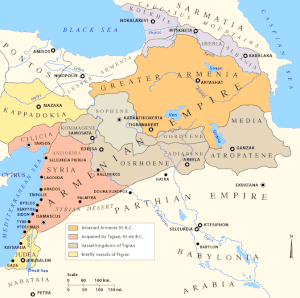Adiabene
Adiabene (from the Ancient Greek Ἀδιαβηνή, Adiabene, itself derived from Classical Syriac: ܚܕܝܐܒ, Ḥaḏy’aḇ or Ḥḏay’aḇ, Middle Persian: Nodshēragān,[3][4] Armenian: Նոր Շիրական, Nor Shirakan) was an ancient kingdom in Assyria,[5][6][7][8] with its capital at Arbela (modern-day Erbil, Iraq).
Adiabene | |||||||||||
|---|---|---|---|---|---|---|---|---|---|---|---|
| 15–116 | |||||||||||
 Adiabene within Armenian Empire under the reign of Tigranes the Great | |||||||||||
| Status | Vassal of the Kingdom of Armenia, Parthian Empire, Sasanian Empire Province of the Sasanian Empire (226–649) | ||||||||||
| Capital | Arbela | ||||||||||
| Common languages | Classical Syriac | ||||||||||
| Religion | Ashurism, Judaism, Zoroastrianism, Christianity, Manichaeism | ||||||||||
| Government | Monarchy | ||||||||||
| King | |||||||||||
• around 15 CE | Izates I | ||||||||||
• 20s? – c. 36[1] | Monobaz I | ||||||||||
• c. 36 - c. 55/59 | Izates II[2] | ||||||||||
| Monobaz II | |||||||||||
• ? - 116 | Meharaspes | ||||||||||
| Historical era | Antiquity | ||||||||||
• Established | 15 | ||||||||||
• Disestablished | 116 | ||||||||||
| |||||||||||
Adiabenian rulers converted to Judaism from paganism in the 1st century.[9] Queen Helena of Adiabene (known in Jewish sources as Heleni HaMalka) moved to Jerusalem, where she built palaces for herself and her sons, Izates bar Monobaz and Monobaz II at the northern part of the city of David, south of the Temple Mount, and aided the Jews in their war with Rome.[10] According to the Talmud, both Helena and Monobaz donated large funds for the Temple of Jerusalem. After 115 CE, there are no historic traces of Jewish royalty in Adiabene.
Location
Adiabene occupied a district in Median Empire between the Upper Zab (Lycus) and the Lower Zab (Caprus), though Ammianus speaks of Nineveh, Ecbatana, and Gaugamela as also belonging to it.[11] Although nominally a dependency of the Parthian Empire, for some centuries, beginning with the 1st century BCE, it was independent. By the late 1st century CE, its borders extended as far as Nisibis.[lower-alpha 1] In the Talmudic writings the name occurs as חדייב ,חדייף and הדייב. Its chief city was Arbela (Arba-ilu), where Mar Uqba had a school, or the neighboring Hazzah, by which name the later Arabs also called Arbela.[14]
In Kiddushin 72a the Biblical Habor is identified with Adiabene,[15] but in Yerushalmi Megillah i. 71b with Riphath.[16] In the Targum to Jeremiah li. 27, Ararat, Minni, and Ashkenaz are paraphrased by Kordu, Harmini, and Hadayab, i.e., Corduene, Armenia, and Adiabene; while in Ezekiel xxvii. 23 Harran, Caneh, and Eden are interpreted by the Aramaic translator as "Harwan, Nisibis, and Adiabene."
Population
Adiabene had a mixed population, while the Syriac language was dominant spoken by Assyrians. According to Pliny, four tribes inhabited the region of Adiabene: Orontes, Alani, Azones and Silices.[17] The account of Josephus' Antiquities of the Jews shows that there was a substantial Jewish population in the kingdom, which led to the establishment of a prominent rabbinic academy in Arbela. During the Sassanid era, Persians came to the fore politically. The difficult mixing of cultures can be seen in the story of the martyrdom of Mahanuš, a prominent Iranian Zoroastrian who converted to Christianity.[18] In later times Adiabene became an archbishopric, with the seat of the metropolitan at Arbela.[19]
Based on names of the Adiabenian rulers, Ernst Herzfeld suggested a Saka/Scythian origin for the royal house of the kingdom;[20][21] however, later progress in Iranian linguistic studies showed that these names were common west middle Iranian names.[22] It has been suggested that the royal house of Adiabene, after fleeing Trajan's invasion, established the later Amatuni dynasty which ruled the area between the lakes Urmia and Van.[23][24]
Adiabene was a district in Mesopotamia between upper and lower Zab and was a part of the Neo Assyrian Empire and inhabited by Assyrians even after the fall of Nineveh. It was an integral part of Achaemenid Assyria (Athura) and Sassanid Assyria (Assuristan).[25][26] The region was later made a part of the Roman province of Assyria after the invasion by Trajan in 116.[27]
According to Patricia Crone and Michael Cook, when the heartland of Assyria was back into focus in early Christianity (during the Parthian era and about six centuries after the fall of the Assyrian Empire), "it was with an Assyrian, not a Persian let alone Greek, self-identification: the temple of Ashur was restored, the city was rebuilt, and an Assyrian successor state that returned in the shape of the client kingdom of Adiabene." The Jewish historian Flavius Josephus states that the inhabitants of Adiabene were Assyrians.[28][28]
(For subsequent history, see Erbil; Assyrian people, Roman Empire, Iraq).
History
In ancient times Adiabene was an integral part of Assyria.
Achaemenid Persian Empire
Under the Achaemenid Persian kings, Adiabene seems for a time to have been a vassal state of the Persian Empire. At times the throne of Adiabene was held by a member of the Achaemenid house; Ardashir III (king from 628 to 630 CE), before he came to the throne of Persia, had the title "King of Hadyab".[29] The Ten Thousand, an army of Greek mercenaries, retreated through Adiabene on their march to the Black Sea after the Battle of Cunaxa.
Queen Helena's conversion to Judaism
According to Jewish tradition, Helena, the Queen of Adiabene converted to Judaism from paganism in the 1st century.[30] Queen Helena of Adiabene (known in Jewish sources as Heleni HaMalka) moved to Jerusalem where she built palaces for herself and her sons, Izates bar Monobaz and Monobaz II at the northern part of the city of David, south of the Temple Mount, and aided Jews in their war with Rome. Queen Helena's sarcophagus was discovered in 1863. A pair of inscriptions on the sarcophagus, "tzaddan malka" and "tzadda malkata," is believed to be a reference to the provisions (tzeda in Hebrew) that Helena supplied to Jerusalem's poor and to the Jewish kingdom in general. According to Josephus "the queen converted to Judaism together with her son Monobaz II, under the influence of two Jews. Another tradition has it that she met a Jewish jewelry merchant in Adiabene by the name of Hanania or Eliezer, who told her about the people of Israel and persuaded her to join them.[31] All historic traces of Jewish royalty in Adiabne ended around 115 CE, but these stories made huge impact on rabbinic literature and Talmud.[32] Nominally Zoroastrian, the people of Adiabne were tolerant toward Judaism, and permitted the establishment of Jewish communities there, The Jews of Edessa, Nisibis, and Adiabene repaid them by being among the most vigorous opponents of Trajan. In late second century Christianity rapidly spread among Zoroastrians and those formerly professing Judaism. When Christianity became the official religion of the Roman empire under Constantine, the position of Adiabenian Christians was naturally exacerbated, since they were seen as potentially disaffected by the zealously Zoroastrian Sasanians.[33]
Hellenistic Period
The little kingdom may have had a series of native rulers nominally vassal to the Macedonian, Seleucid and later Armenian (under Tigranes the Great) empires.
Parthian Empire
It later became one of the client kingdoms of the Parthian empire. During the 1st century BCE and the 1st century CE, it gained a certain prominence under a series of kings descended from Monobaz I and his son Izates I. Monobaz I is known to have been allied with king Abennerig of Characene, in whose court his son Izates II bar Monobaz lived for a time and whose daughter Symacho Izates married, as well as the rulers of other small kingdoms on the periphery of the Parthian sphere of influence.
Roman intermezzo (117-118)
The chief opponent of Trajan in Mesopotamia during the year 115 was the last king of independent Adiabene, Meharaspes. He had made common cause with Ma'nu (Mannus) of Singar (Singara). Trajan invaded Adiabene, and made it part of the Roman province of Assyria; under Hadrian in 117,[5] however, Rome gave up possession of Assyria, Mesopotamia, and Armenia.
In the summer of 195 Septimius Severus was again warring in Mesopotamia, and in 196 three divisions of the Roman army fell upon Adiabene. According to Dio Cassius, Caracalla took Arbela in the year 216, and searched all the graves there, wishing to ascertain whether the Arsacid kings were buried there. Many of the ancient royal tombs were destroyed.
Sassanid Persia
Despite the overthrow of the Parthians by the Sassanids in 224 CE, the feudatory dynasties remained loyal to the Parthians, and resisted Sassanid advance into Adiabene and Atropatene. Due to this, and religious differences, Adiabene was never regarded as an integral part of Iran, even though the Sassanids controlled it for several centuries.
After the Roman Empire gradually made Christianity its official religion during the fourth century, the inhabitants of Adiabene, who were primarily Assyrian Christians, sided with Christian Rome rather than the Zoroastrian Sassanids. The Byzantine Empire sent armies to the region during the Byzantine-Sassanid Wars, but this did nothing to change the territorial boundaries. Adiabene remained a province of the Sassanid Empire until the Muslim conquest of Persia.[34]
The region was recorded as Nod-Ardadkhshiragan or Nod-Ardashiragan in Sasanian period.
Rulers
All dates are approximate.
- Abdissar (2nd c. BCE)[35]
- Izates I (? - c. 15/30 CE)[36]
- Bazeus Monobazus I (20s? – c. 36)[1]
- Heleni (c. 30 – c. 58)
- Izates II bar Monobazus (c. 36 – 55/59)
- Vologases (a Parthian rebel opposing Izates II) (c. 50)
- Monobazus II bar Monobazus (55/59[1] – late 60s/mid-70s)
- Meharaspes (? – 116)
- To the Roman Empire (116–117)
- Rakbakt (?-191) (A Parthian governor of Alanian descent)[37]
- Narsai of Adiabene (c. 191–200)
- Shahrat (Shahrad) (c. 213-224)
- To the Sassanid Empire (226–649)
- Ardashir II (344-376)
Bishops
Between the 5th and the 14th centuries Adiabene was a metropolitan province of the Assyrian Church of the East. The Chronicle of Erbil, a purported history of Christianity in Adiabene under the Parthians and Sassanians, lists a number of early bishops of Erbil. The authenticity of the Chronicle of Erbil has been questioned, and scholars remain divided on how much credence to place in its evidence. Some of the bishops in the following list are attested in other sources, but the early bishops are probably legendary.
- Pkidha (104–114)
- Semsoun (120–123)
- Isaac (135–148)
- Abraham (148–163)
- Noh (163–179)
- Habel (183–190)
- Abedhmiha (190–225)
- Hiran of Adiabene (225–258)
- Saloupha (258–273)
- Ahadabuhi (273–291)
- Sri'a (291–317)
- Iohannon (317–346)
- Abraham (346–347)
- Maran-zkha (347–376)
- Soubhaliso (376–407)
- Daniel (407–431)
- Rhima (431–450)
- Abbousta (450–499)
- Joseph (499–511)
- Huana (511–?)
See also
- Adiabene (East Syrian Ecclesiastical Province)
- Assuristan
- Assyria (Roman province)
- Osroene
- Sennacherib II
- Nor Shirakan
Notes
- Nisibis was not part of Adiabene before 36, when Artabanus presented the city to Izates as a reward for his loyalty. Strabo[12] implies that Nisibis was not part of Adiabene, while Pliny[13] reports that Nisibis and Alexandria were chief cities of Adiabene. On the remnants of the ten tribes in the Khabur area, see Emil Schiirer, The Jewish People in the Time of Jesus Christ, II, ii, pp. 223-25; Avraham Ben-Yaakov, Jewish Communities of Kurdistan, [in Hebrew] (Jerusalem, 1961), pp. 9-11; Neusner, Jacob (1964). "The Conversion of Adiabene to Judaism: A New Perspective". Journal of Biblical Literature. 83 (1): 60 (note 3). JSTOR 3264908.
References
- (Frankfurt/Main), Bringmann, Klaus. "Monobazus". brillonline.com. Retrieved 11 April 2018.
- Nimmo, Douglas John. "Izates II King of Adiabene's Tree". June 8, 2011. geni.com. Retrieved 30 April 2014.
- ŠKZ
- Richard Nelson Frye, 1984, The History of Ancient Iran: Volume 3, Part 7 - Page 222
- "The Chronicle of Arbela" (PDF). Archived from the original (PDF) on 2004-04-28. Retrieved 2007-10-06.
In 115, the Romans invaded Adiabene and named it Assyria.
- The Biblical Geography of Central Asia: with a General Introduction, by Ernst Friedrich Karl Rosenmüller. Page 122.
- In Memory of Rabbi and Mrs. Carl Friedman: Studies on the Problem of Tannaim in Babylonia (ca. 130–160 C. E.) Author(s): Jacob Neusner Source: Proceedings of the American Academy for Jewish Research, Vol. 30 (1962), pp. 79–127.
- Ammianus Marcellinus, another fourth-century writer. In his excursus on the Sasanian Empire, he describes Assyria in such a way that there is no mistaking he is talking about lower Mesopotamia (Amm. Marc. XXIII. 6. 15). For Assyria, he lists three major cities-Babylon, Ctesiphon and Seleucia (Amm. Marc. xxIII. 6. 23), whereas he refers to Adiabene as 'Assyria priscis temporibus vocitata' (Amm. Marc. xxIII. 6. 20).
- Gottheil, Richard. "Adiabene". Jewish Encyclopedia. Retrieved 8 November 2011.
- Neusner, Jacob (1964). "The Conversion of Adiabene to Judaism: A New Perspective". Journal of Biblical Literature. 83 (1): 60–66. JSTOR 3264908.
- "Hist." xviii., vii. 1
- Geogr. xvi, 1, 1
- Hist. Nat. vi, 16, 42
- Yaqut, Geographisches Wörterbuch, ii. 263; Payne-Smith, Thesaurus Syriacus, under "Hadyab"; Hoffmann, Auszüge aus Syrischen Akten, pp. 241, 243.
- Compare Yebamot 16b et seq., Yalqut Daniel 1064
- Genesis x. 3; compare also Genesis Rabba xxxvii.
- Pliny the Elder, The natural history, book VI, chap. 30
- Fiey, J. M. (1965). Assyrie chrétienne I. Beirut: Imprimerie catholique.
- Hoffmann, "Akten," pp. 259 et seq.
- Ernst Herzfeld, 1947, Zoroaster and his world, Volume 1, p. 148, Princeton university press, University of Michigan, 851 pages
- Ernst Herzfeld, Gerold Walser, 1968, The Persian Empire: Studies in geography and ethnography of the ancient Near East, p. 23, University of Michigan, 392 pages
- Helmut Humbach, Prods Oktor Skjaervo, 1983, The Sassanian Inscription of Paikuli Pt. 3,1, p. 120, Humbach, Helmut und Prods O. Skjaervo, Reichert, 1983, ISBN 3882261560/9783882261561
- Jacob Neusner, 1969, A History of the Jews in Babylonia, Volume 2, p. 352-353, Brill, 462 pages
- Jacob Neusner, 1990, Judaism, Christianity and Zoroastrianism in Talmudic Babylonia, Volym 204, p. 103-104, University of Michigan, Scholars Press, 228 pages
- Whinston, William. Translator. The Works of Josephus. Massachusetts: Hendrickson Publishers Inc. 1999
- Gibbon, Edward. The History of the Decline and Fall of the Roman Empire. David Womersley, ed. Penguin Books, 2000
- "Adiabene:". JewishEncyclopedia.com. Retrieved 2011-09-19.
- Crone, Patricia; Cook, Michael (21 April 1977). "Hagarism: The Making of the Islamic World". CUP Archive. Retrieved 11 April 2018 – via Google Books.
- Nöldeke, Geschichte der Perser, p. 70.
- "Helena". www.jewishvirtuallibrary.org. Retrieved 11 April 2018.
- Shapira, Ran (1 October 2010). "A Royal Return". Retrieved 11 April 2018 – via Haaretz.
- The Other Zions: The Lost Histories of Jewish Nations By Eric Maroney P:97
- electricpulp.com. "ADIABENE – Encyclopaedia Iranica". www.iranicaonline.org. Retrieved 11 April 2018.
- electricpulp.com. "Encyclopædia Iranica - Home". www.iranica.com. Retrieved 11 April 2018.
- (Merciak), Michal. "Abdissar". Cambridge.org. Retrieved 15 May 2020.
- (Pretzfeld), Schottky, Martin. "Izates". brillonline.com. Retrieved 11 April 2018.
- John Bagnell Bury, Stanley Arthur Cook, Frank E. Adcock, 1969, The Cambridge ancient history: Volume 11, p. 111, The University press, University of Michigan
References
- Brauer, E., The Jews of Kurdistan, Wayne State University Press, Detroit, 1993.
- Solomon Grayzel, A History of the Jews,New York: Mentor, 1968.
- Gottheil, Richard. "Adiabene". Jewish Encyclopedia. Funk and Wagnalls, 1901-1906.; which cites:
- Josephus, Jewish Antiquities xx. 2, § 4;
- idem, Wars of the Jews. ii. 19, § 2; iv. 9, § 11; v. 2, § 2; 3, § 3; 4, § 2; 6, § 1, noting that Josephus probably got his information from Adiabenian Jews in Jerusalem (Von Gutschmid, Kleine Schriften, iii. 4).
- Pliny the Elder, Historia Naturalis, v. 66, vi. 44 et seq.
- Ammianus, History, xviii. 7, § 1; xxiii. 6, § 21
- Strabo, Geography, xvi. 745 et seq.
- Brüll, Adiabene, in Jahrbuch i. 58 et seq.
- Grätz, Heinrich, in Monatsschrift, 1877, xxvi. 241 et seq., 289 et seq.
- Von Gutschmid, Gesch. Irans, pp. 140 et seq.
- Schürer, Gesch. ii. 562.
- Josephus, Jewish Antiquities xx. 2, § 4;
External links
- Bishops of Adiabene
- History of Aramaic (includes references to Adiabene)
- The forced conversion of the Jewish community of Persia and the beginnings of the Kurds
- "Assyria" at Livius.org
- "Arbela" at Livius.org
- Adiabene, Jewish Kingdom of Mesopotamia (different page see above)
- Info from Jewish Encyclopedia


